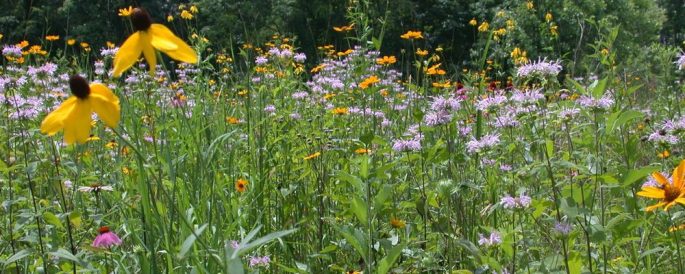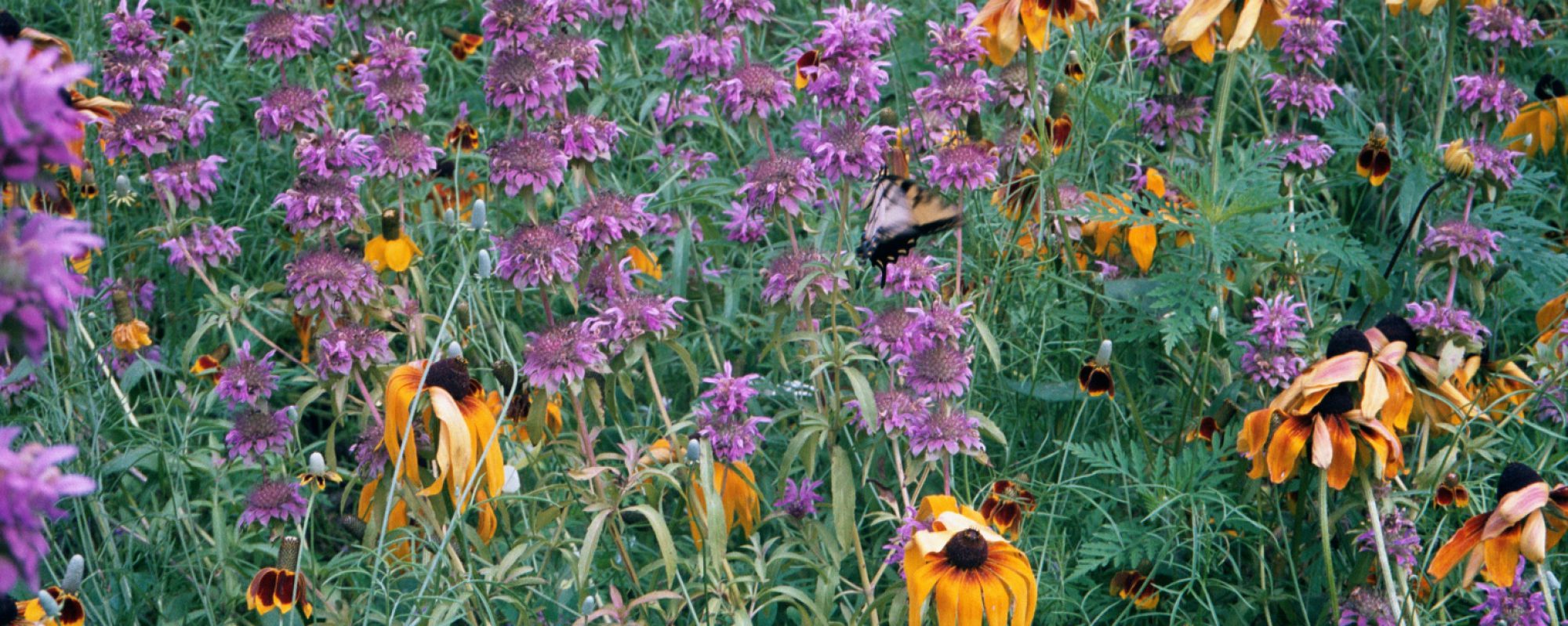
We all love the look of a nicely landscaped yard. Native planting can be a beautiful, low-cost alternative to traditional landscaping that uses turf grass and ornamental non-native plants. Native plantings can be practical nearly anywhere in your yard, and can be designed specifically to best enhance and beautify your property.
What’s the difference between a native plant and a non-native plant?
The plants present in North America at the time Europeans arrived are typically considered native. Plant species that have been brought in are called non-native, or introduced species. Native plants have many benefits over non-native plants, both for your pocketbook and your environment.
 Native plants have adapted to our local conditions over thousands of years, and can survive our wet springs and dry summers with little maintenance needed. Turf grass roots only grow to about 4 inches deep; native plant roots can grow 5-10 feet deep and even up to 15 feet deep in some soils! Their deeper roots make them much more drought-resistant than turf grass and make spaces in the soil for water to soak into, which lessens stormwater impacts.
Native plants have adapted to our local conditions over thousands of years, and can survive our wet springs and dry summers with little maintenance needed. Turf grass roots only grow to about 4 inches deep; native plant roots can grow 5-10 feet deep and even up to 15 feet deep in some soils! Their deeper roots make them much more drought-resistant than turf grass and make spaces in the soil for water to soak into, which lessens stormwater impacts.
Once established, native plants usually require little to no irrigation or fertilization so you can spend less money on watering and fertilizing your yard while protecting our water quality and quantity. Native plants are resistant to most local pests and diseases, reducing the use of harmful pesticides and fungicides.
Many native plants also produce beautiful flowers that attract the butterflies and other native pollinators our fruits, vegetables, and other garden plants need. Native plants are an excellent choice for attractive, low-maintenance gardening and landscaping that benefit and protect our local natural resources.
The following native, water-loving tree species have deep roots that form pathways for stormwater infiltration into the ground:
- Swamp white oak (Quercus bicolor)
- Swamp white oak does well in wet woods and wetlands and is tolerant of poor drainage as well as drought conditions. It thrives in full sun to partial sun but is shade tolerant during its youth.
- These trees grow about a foot a year and reach a height 50 to 60 feet and a spread of 60 feet. Space oak saplings 30 to 40 feet apart to accommodate their spread.
- River birch (Betula nigra)
- This tree does well in wet, rich, deep soils and grows in full to partial sun.
- This tree grows rapidly and may grow to a height of 50 feet and a spread of 40 feet.
- Sycamore (Platanus occidentalis)
- Sycamores reach a mature height of 80 feet and a spread of 60 feet.
- They do well in full to partial sun and in wet, well-drained to moderately drained soils such as in wet areas of woodlands.
If you decide to plant trees, consider planting the saplings during their fall dormancy so they will expend their energy on their roots, rather than foliage production. The cooler temperatures and regular rainfall during this time of year will also help reduce stress on the trees. Dig your hole approximately ½ inch shallower than the soil depth and make the hole approximately three times the container’s width at the soil line. Be sure to loosen any entangled roots. Backfill the hole with the same soil you removed, break up any large clods, and gently tamp the soil to remove air pockets as you work. The leftover soil can be used to build a small 2 – 3-inch mound around the edge of the planting hole to direct moisture to the root balls. After planting and watering, consider adding a 2 – 4-inch layer of organic mulch, such as wood chips to help retain moisture, boost soil nutrients, and discourage weed growth. Be sure to keep the base of the tree, including the root flares, exposed and clear of mulch and soil (avoid creating mounds of soil or mulch around the base of the tree). This prevents moisture from building up along the root collar and causing decay and ultimate decline of the tree.
You may also consider the following native shrub options on your property:
- Buttonbush (Cephalanthus occidentalis)
- Buttonbush does well in full sun. It reaches a height of 7 feet and a spread of 15 feet. It does best in soils that are permanently moist.
- Redosier Dogwood (Cornus stolonifera)
- This shrub reaches a height of 9 feet and a spread of 10 feet at maturity. It prefers full sun and partial shade. It prefers wet moist soils and does not tolerate excessively dry soil. It is a fast-grower, with height increases of more than 24 inches per year.
- Grey Stem Dogwood (Cornus racemosa)
- This shrub grows to a height of 15 feet and a spread of up to 15 feet at maturity. It grows at a slow rate, with height increases less than 12 inches per year. It prefers full sun and partial shade and can tolerate wet conditions as well as drought.
- Silky Dogwood (Cornus amomum)
- Silky dogwoods reach a height of 10 feet and a spread of 10 feet. They prefer full sun to partial shade and moist to wet soils. It can adapt to dry soils and soils that are wet in winter and spring but dry in summer and autumn.
- Spicebush (Lindera benzoin)
- Spicebush reaches a height of 12 feet and a spread of 15 feet. It prefers permanently moist to wet soils. It prefers full to partial shade and has yellow flowers similar to forsythia.
- Virginia Sweetspire (Itea virginica)
- This species matures to 4 feet tall by 6 feet wide. It performs well in both full sun and full shade and can tolerate both dry conditions and some standing water.
- Red Chokeberry (Aronia arbutifolia)
- This shrub grows to a height of up to 10 feet and a spread of 5 feet. It does well in well-drained soils with average moisture and full sun or partial shade. This is a native alternative to the non-native burning bush (Euonymus alatus).
- Black Chokeberry (Aronia melanocarpa)
- Black chokeberries have highly fibrous root systems that hold soil well. They prefer moist, well-drained soils. They can tolerate dry summer soils. They grow to a mature height of 8 feet and a spread of eight feet.
The following ground cover species are a great option for shaded areas:
- Native ferns such as sensitive fern (Onoclea sensibilis), cinnamon fern (Osmunda cinnamomea), marsh fern (Thelypteris palustris), ostrich fern (Matteuccia struthiopteris), royal fern (Osmunda regalis), or spinulose shield fern (Dryopteris carthusiana).
- Native sedges such as Gray’s sedge (Carex grayi) or Frank’s sedge (Carex frankii).
- Wildflowers such as bluebells (Mertensia virginica), bee balm (Monarda didyma), marsh bue violet (Viola cucullate), common blue violet (Viola sororia), blue flag iris (Iris versicolor), cardinal flower (Lobelia cardinalis), or wild hyacinth (Camassia scilloides).
Avoid planting these non-native plants: Japanese honeysuckle, Japanese knotweed, autumn olive, glossy buckthorn, purple loosestrife, common reed, reed canary grass, English ivy, and privet. These plants can take over and push native plants out.
Resources
Native Plant List – Indy Sustainability Office
Build Your Own Native Planting Area (with plans/layouts) – Indy Sustainability Office
General Information on Gardening with Natives in Indiana
Cost-Share Information – Marion County SWCD
Indiana Native Plant Kits for Purchase
